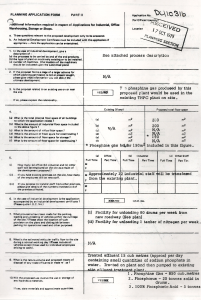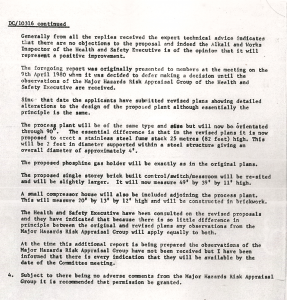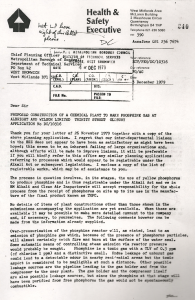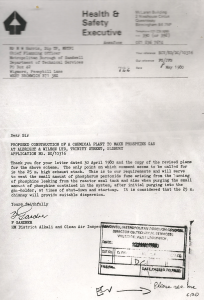Phosphine
Phosphine, chemical formula PH3 is a colourless, highly reactive and extremely poisonous gas, which has a garlic/rotten fish odour at concentrations above 2 parts per million by volume. Its toxicity and oxidation state in terms of other phosphorus related substances is shown below.
MAMMALIAN TOXICOLOGY AND TOXICITY TO AQUATIC ORGANISMS OF WHITE PHOSPHORUS AND “PHOSSY WATER” A WATERBORNE MUNITIONS MANUFACTURING WASTE POLLUTANT – A LITERATURE EVALUATION Dickinson Burrows, e t al 1973 presents the following information.
NB. These are clearly very small amounts.
The risks that phosphine poses was provided by the Health and Safety executive in their report concerning the uncontrolled release of the gas that took place at the Trinity Street site in 2009.
Historic Production
In the Twentieth Century we learn first hand from Albright and Wilson as to how they marketed this poisonous gas in liquid form. It is clear from this 1933 publication “fine chemicals” that they were manufacturing it before The Second World War.
The method of manufacture according to an Albright World article from around 1986 stated “phosphine has been manufactured on site for over 40 years but was produced as a by-product in hypophosphite manufacture from the early 1930’s until the start up of the phosphine plant in 1980.”
Phosphine Number 1 plant
In 1980, Albright and Wilson submitted plans under application DC/10316 for new phosphine plant at Trinity Street, This was to adjoin the proposed phosphoric acid plant under another application.
The key point of this application concerns the amount of the substances required in the process.
So the quantities were 850 cubic metres of phosphine gas, 20 tonnes of white phosphorus in solid drums, and 5 tonnes of 100% phosphoric acid.
From this application we appear to get conflicting opinions from the so called “experts” commenting on the proposal. For example in the report to the planning committee it is stated that the production of phosphine at the site is already an established process and that “the chief fire officer points out that no serious incidents have occurred.” As can be demonstrated from this article, this statement by the officer (who in his own words describes the premises as being designated “special risk”), was in fact false.
Furthermore in the following paragraph of the report
“The chief alkali inspector points out that he has been trying to persuade the company for some years to alter the process for phosphine gas manufacture since fumes arrestment on the current process is virtually impossible and he is of the opinion that the proposed new method is the only solution.”
This is quite a statement in that it appears that the authorities appear blissfully complacent in the fact that a toxic gas fume is escaping from this plant. The hypophosphites plant was known to be a dangerous and disgusting emitter to the local environment.
Albright and Wilson typically submitted a “chemsplaining” application , typical of all their previous others, whilst also able to insert some advertising for good measure.
Here is the whole statement and explanation of how the phosphine number one plant works in their own words. It is worth bearing in mine that the pathetic Health and Safety Executive, who had nothing worthwhile to say in objection when this hideous plant was commissioned, tried to prevent the release of how it operated when I asked for their report into the 2009 leak from this same plant. That was overturned when I applied to the information commissioner’s office. I DO HOPE THIS INFORMATION IS “USEFUL.” 😆
“New phosphine plant- Oldbury
Submission for planning application.
1 Introduction
The project comprises a new 300 t.p.a phosphine plant. Phosphine, a gas, is used in an existing plant to produce T.H.P.C , a chemical which imparts flame resistance to cotton and other fabrics. Phosphine has been made at Oldbury by another process for over 20 years. The present proposal is to provide a new plant using improved technology in order to phase out the older facilities.
2. Process description.
See figure 1 for block flow diagram.
Phosphorus storage
Phosphorus will be received from the Albright and Wilson factory at Portishead in 20 gallon drums. Each drum contains about 190 kgs of solid phosphorus together with a protective covering of water. The drums will be stored on a concrete kerbed area prior to use.
Phosphorus Feed system.
The phosphorus drums, about one every three hours, will be hoisted up and lowered into a 3m3 stainless steel vessel filled with hot water. The phosphorus melts and collects in the lower part of the melter from where it is transferred by gravity to a small stainless steel displacement vessel. Here, the phosphorus is displaced by water to act as feed in the next stage of the process.
Phosphorus converter.
The converter is a 1.3m3 stainless steel vessel, cooled by water and heated inductively by electricity. The converter is held at a temperature of 265 °C to partially convert the white liquid phosphorus feed to solid ‘red’ phosphorus.
Phosphine reactor
This vessel , of 1.8m diameter and 2,8 m height (outer dimensions) consists of a jacketed, water cooled stainless steel vessel lined with carbon. A quantity of phosphoric acid, a by-product of the reaction, is retained in the reactor and the fresh phosphorus feed added. Steam is admitted to the reactor converting the solid red phosphorus to the gaseous product, phosphine. The reactor is operated at 290 °C and electrical heat is provided by a submerged electrode.
A water seal tank , 0.6m3 capacity , serves both the convertor and the reactor to prevent overpressurisation of the equipment. This occurrence should be rare. If it does happen, phosphine would be emitted at this point where it would be expected to catch fire.
2 Process description continued
By product acid
A by-product of the process is phosphoric acid. This is removed from the reactor, cooled and passed to a 3.4m3 stainless steel retention vessel. This allows for the settling of entrained red phosphorus which is returned to the reactor. The clarified acid will then be transferred to phosphoric acid storage facilities in the main works.
Phosphine purification
The phosphine gas leaving the reactor contains a considerable quantity of phosphorus. The vast majority of this is removed from the gas in a 0.76m diameter water spray column, 3.3 m high. At the base of the column is a stainless steel tank which serves as a reservoir for the condensed phosphorus, which is returned to the phosphorus melter, and for the condensing water which is cooled and recycled to the condensing column.
The phosphine leaving the first condensing column is then further processed in a packed scrubbing column. This column is operated using a caustic soda solution which reacts with any remaining phosphorus, thereby destroying it. Caustic soda is stored in a 1.8m3 mild steel tank and added at a controlled rate to the sump of the scrubbing column. From there, the liquor is cooled and circulated around the column.
Gas storage
The phosphorus free phosphine passes through a 0.5m3 carbon steel vessel which provides a water seal between the gas storage and the reaction areas. Storage of the gas is in a 850m3 mild steel gas holder. The gas holder, a single lift spiral guided unit, has a capacity of about 20 hours and enables the phosphine producing plant to be decoupled. The pressure of the gas in the holder is about 6” water gauge.
Gas is removed from the holder on demand and is compressed in a liquid- ring type compressor to 20 p.s.i and piped to the user plant.
Effluent Section
All liquid effluents from the plant , which contain traces of phosphorus or phosphine, pass to the effluent sump, a 4,5m3 plastic tank. Here the phosphorus is destroyed by the addition of caustic soda. A small quantity of chlorine is added to the liquid, producing a weak solution of sodium hypochlorite, which in turn destroys any dissolved phosphine before the effluent is discharged into the site’s effluent system..
Utilities
The project uses the following utilities
Cooling water from the existing site facilities.
Steam water from existing site facilities.
Hot water, generated in a calorifier from steam and water.
Nitrogen for purging of all equipment, to be provided from a storage unit.
Electrical power from the existing site mains.
Plant structure
The plant will be located on a self-supporting steel structure. The top of the structure will be sheeted to provide some weather protection for the manual operations on the plant. The floor of the plant will be concreted and provided with a kerb to contain spillage.
Phosphine technology
Over the years, Albright and Wilson have carried out extensive development work of the manufacture of phosphine. Part of the technology was licensed to Cyanamid Canada Inc. who built a pilot plant at Welland , Canada. The plant described here is largely based on the Cyanamid operating and development experience, supplemented by our own latest development work.
Safety
White phosphorus is a solid at room temperature. It burns spontaneously upon contact with air and is therefore always handled under water. The solid melts at 44 °C to form a viscous liquid, of similar properties, which again is handled under water.
Phosphine is a colourless gas at room temperature and pressures and is toxic. The gas is easily oxidised by air and other oxidising agents and therefore usually ignites on exposure to air.
Workforce
The plant will operate on a continuous seven day week basis. The manning level is likely to be two men per shift with one day supervisor.
Amenity block/control room
A control room will be provided for the plant with washing, changing and toilet facilities.”
It is worth emphasising the information supplied by Albright and Wilson at this time.
“A water seal tank , 0.6m3 capacity , serves both the convertor and the reactor to prevent overpressurisation of the equipment. This occurrence should be rare. If it does happen, phosphine would be emitted at this point where it would be expected to catch fire. “
There is no statement as to what would happen if it were to catch fire, or any mention of health and safety measures- as was the case some 30 years later!
Unfortunately the health and safety executive “clean air inspector” LOL (Frank Gardner) also failed to adequately address the issue in their submissions, quite happy in his failed job role to conclude :
“Phosphine is currently made at the works by the reaction of magnesium aluminium phosphide (MAP) with water and the manufacture of MAP is by means of an almost uncontrollable reaction leading to the spontaneous emission at frequent intervals of large amounts of phosphorus fume, currently vented by a brick chimney from the North-East corner of the works.”

Why did this man and others turn a blind eye to unacceptable pollution that they knew was occurring?
The most telling part of this application however is a letter from a name that appears to crop up regularly around this time and connected with this companies failures and subterfuge- that of R Woodhead. This letter is some piece of work and is a perfect demonstration of the lengths that this company would go to get what they wanted and believed how untouchable they were. First the letter.
The following can be stated about Woodhead’s letter.
- Woodhead fears that an outside consultant may be appointed by the council to look seriously at their proposals- and of course the safety risks which they do not address in their application.
- The words “critical” and vital” are used in respect of the application , and it appears desperate. “It is imperative that all steps are taken to ensure that there are no delays.” Just who the hell does he think he is here?
- “Accordingly I must do everything I possibly can to ensure that we do not have any hold up caused by the members of the committee insisting on an outside consultant being involved and thereby prolonging the matter further. “
- “I would therefore be grateful if you could do anything in your power to avoid the engagement of such a consultant and I will do everything I possibly can to assist if you let me know what is required. ” Is this coded language for how much money will it take to buy you off?
- Woodhead then suggests an Albright and Wilson presentation team could show the committee a plan of the proposed site- but what good would that be to a bunch of laymen councillors with no insight into the chemistry involved when the firm making the application has done “everything it possibly can” to avoid them having independent advice?
It appears unfortunately that the officers of the council did not take an outside consultant, nor investigate the potential problems that the plant could generate. The application was granted and the plant shown below built. Unfortunately the application did not look at technical detail, and how Albright and Wilson would cut costs in critical pieces of machinery like the rodder system which led to the uncontrolled release of a highly toxic gas. Perhaps independent advice may have picked up on such a possibility not happening.



















